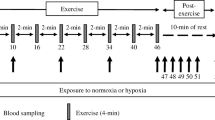Abstract
Dichloroacetate (DCA), a stimulator of the pyruvate dehydrogenase complex, decreases lactate levels and peripheral resistance and increases cardiac output. This study was performed to examine the effects of DCA on exercise performance in humans. Eight healthy male volunteers (age 20–28 years) were tested by bicycle spiro-ergometry using a microprocessor-controlled gas analysis system after infusion of DCA (50 mg/kg body weight) or saline. Prior infusion of DCA significantly reduced the increase of lactate levels during exercise when compared with infusion of saline (1.40±0.21 vs 2.10±0.09 mmol·l−1 at 50% of the expected maximal working capacity, P<0.05; 8.53±0.45 vs 9.92±0.59 mmol·l−1 at maximal working capacity, P<0.05). Oxygen uptake increased significantly after DCA when compared with saline from 7.5±0.4 vs 7.4±0.5 to 27.2±1.5 vs 23.7±1.7 (P<0.05) at anaerobic threshold and to 35.6±1.7 vs 30.5±1.0 ml · kg−1 min−1 (P<0.05) at maximal exercise capacity. Following DCA infusion the workload at which the anaerobic threshold was reached was significantly higher (160±7 vs 120±5 W, P<0.05) and the maximal working capacity was significantly increased (230±9 vs 209±8 W, P<0.05). In summary, DCA reduced the increase of lactate levels during exercise and increased oxygen uptake at the anaerobic threshold and at maximal working capacity, which was significantly increased. These results warrant further studies on a potential therapeutic application of DCA in patients with reduced exercise capacity.
Similar content being viewed by others

References
Brooks GA (1985) Anaerobic threshold: review of the concept and directions for future research. Med Sci Sports Exerc 17:22–31
Crabb DW, Yount EA, Harris RA (1981) The metabolic effects of dichloroacetate. Metabolism 30:1024–1039
Graf H, Leach W, Arieff AI (1985) Effect of dichloroacetate in the treatment of lactic acidosis in dogs. J Clin Invest 76:919–923
Hayek A, Woodside WF (1980) Short-term influences of dichloroacetate on genetically hyperlipaemic rats. Metabolism 29:120–124
Ludvik B, Peer G, Berzlanovich A, Stifer S, Graf H (1991) Effects of dichloroacetate and bicarbonate on hemodynamic parameters in healthy volunteers. Clin Sci 80:47–51
Merrill GF, Rosolowsky M (1980) Effect of dichloroacetate sodium on lactacidemia of experimental endotoxin shock. Circ Shock 7:13–21
Moore GW, Swift LL, Rabinowitz D, Crofford OB, Oates JA, Stacpoole PW (1979) Reduction of serum cholesterol in two patients with homozygous familial hypercholesterolaemia by dichloroacetate. Atherosclerosis 33:285–293
Norton AC (1979) Development of a microprocessor controlled system for gas exchange and related variables in man during rest and exercise. Reprint No. 025, Beckman, New York
Park R, Radosevich PR, Leach WJ, Seto P, Arieff AI (1983) Metabolic effects of dichloroacetate in diabetic dogs. Am J Physiol 245:E 94-E 101
Randle PJ (1976) Regulation of glycolysis and pyruvate oxidation in cardiac muscle. Circ Res 38 [Suppl 1]:I 8-I 15
Stacpoole PW (1989) The pharmacology of dichloroacetate. Metabolism 38:1124–1144
Stacpoole PW, Moore GW, Kornhauser DM (1978) Metabolic effects of dichloroacetate in patients with diabetes mellitus and hyperlipoproteinaemia. N Engl J Med 298:526–530
Stacpoole PW, Harman EM, Curry StH, Baumgartner TG, Misbin RI (1983) Treatment of lactic acidosis with dichloroacetate. N Engl J Med 309:390–396
Stacpoole PW, Lorenz AC, Thomas RG, Harman EM (1988) Dichloroacetate in the treatment of lactic acidosis. Ann Intern Med 108:58–63
Stacpoole PW, Harwood HJ, Cameron DF, Curry SH, Samuelson DA, Cornwell DE, Sauberlich HE (1990) Chronic toxicity of dichloroacetate: possible relation to thiamine deficiency in rats. Fundam Appl Pharmacol 14:327–337
Wargovich TJ, Macdonald RG, Hill JA, Feldman RL, Stacpoole PW, Pepine CJ (1988) Myocardial metabolic and hemodynamic effects of dichloroacetate in coronary artery disease. Am J Cardiol 61:65–70
Wassermann K, Whipp BJ, Koyal SN, Beaver WI (1973) Anaerobic threshold and respiratory gas exchange during exercise. J Appl Physiol 35:236–243
Wassermann K, Hansen JE, Sue DY, Whipp BJ (1987) Protocols for exercise testing. In: Wassermann K, Hansen JE, Sue DY, Whipp BJ (eds) Principles for exercise testing and interpretation. Lea and Febiger, Philadelphia, pp 58–73
Whitehouse S, Cooper RH, Randle PJ (1974) Mechanism of activation of pyruvate dehydrogenase by dichloroacetate and other halogenated carboxylic acids. Biochem J 14:761–774
Author information
Authors and Affiliations
Rights and permissions
About this article
Cite this article
Ludvik, B., Mayer, G., Stifter, S. et al. Effects of dichloroacetate on exercise performance in healthy volunteers. Pflugers Arch. 423, 251–254 (1993). https://doi.org/10.1007/BF00374403
Received:
Revised:
Accepted:
Issue Date:
DOI: https://doi.org/10.1007/BF00374403



